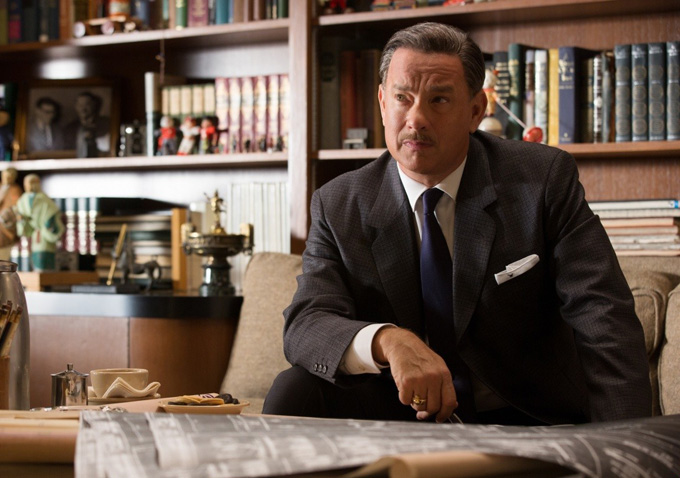
Though the general public doesn’t always share their enthusiasm, Hollywood loves making movies about itself. Whether fictional or based in reality, it’s rare for a year to pass without some kind of film about filmmaking, from classics like “Sunset Boulevard” and “Mulholland Drive” to, uh, not-classics like “Hitchcock.” In recent years, “The Artist” and “Argo” have both been critical and commercial successes (and not coincidentally, Best Picture Oscar winners), and Disney are clearly hoping that the same kind of success follows for “Saving Mr. Banks,” which examines one of the family friendly company’s most beloved films, 1964’s “Mary Poppins,” and their own founder and figurehead, Walt Disney, here played by megastar Tom Hanks.
Hanks and Disney aren’t the film’s center, though. Instead, it’s focused on P.L. Travers (Emma Thompson), the author of the books on which “Mary Poppins” was based. As the film begins, Disney, whose children loved the books, has been pursuing Travers for the film rights for twenty years, and the novelist is now only beginning to entertain the idea because she’s flat broke. So she flies to Los Angeles to spend two weeks working with screenwriter Don DaGradi (Bradley Whitford) and songwriters Richard and Robert Sherman (Jason Schwartzman and B.J. Novak) to see if they can find a script that she’ll approve of in order to finalize the deal. But the prickly Travers is protective to the point of obsession of her characters, objecting to everything from the use of animation to the potential casting of Dick Van Dyke, and it seems like the deal may never get done.

Meanwhile, a second narrative is gradually unveiled, depicting Ginty (Annie Rose Buckley), the author as a young girl in Australia in the early 1900s. With her father Travers Goff (Colin Farrell) and mother Maggie (Ruth Wilson), she’s moved to the remote desert town of Allora where her pops is a bank manager. She’s enthralled by her imaginative, whimsical dad, but it becomes increasingly clear that he’s also an unreliable alcoholic clinging on to his job by a thin thread, driving her mother up the wall in the process. Gradually, Disney begins to piece together the story, and how it figures into the magical flying nanny that Travers created, and the reason that she thinks of the character as family.
As a Disney movie partly about Walt Disney himself, with scenes set at Disneyland, there was always a certain amount of suspicion that the film might be a sort of self-aggrandizing puff piece, designed principally to boost DVD sales of the original film. Happily, that’s far from the case here. The excellent script, credited to Kelly Marcel and Sue Smith, is sensitive and personal, depicting Disney (both the entity and the person) through Travers’ skeptical eye. Hanks’ performance (which is surprisingly, but probably correctly used sparingly; he’s very much a supporting player in the author’s story rather than a secondary lead) also nicely walks the line; it’s hardly warts-and-all, and he’s an ultimately avuncular figure, but the actor does a good job at showing Disney’s Machiavellian, manipulative side.

And as Travers, Thompson is truly excellent. As the star of the Poppins-indebted “Nanny McPhee” franchise, there’s a nice meta quality to her role in the film, but she resists the temptation to echo Julie Andrews—you can see how she’d be the creator of the character, but clearly isn’t the character. It’s the best role she’s had since at least “Primary Colors,” and a fine reminder of what she’s capable of. The support in general is very strong, with textured performances from Whitford, Schwartzman, Novak and Wilson. Especially good are Farrell, as a rather more recognizable kind of screen alcoholic than we usually get, and Paul Giamatti, who does a lot with a little as Travers’ driver and surprising confidante.
It’s funny and, when it comes to it, moving, and nicely captures the creative process in a way that some movies-about-movies struggle with (a scene that contrasts the creation of the song “Fidelity Fiduciary Bank” with a very public breakdown for Farrell is a neat touch). That said, it also feels a little disposable, and some of that might be down to the bland, workmanlike direction from John Lee Hancock. The director has a solid handle on tone, but gives a slightly chocolate box feel to the rest of the film, and perhaps stretches out the Australian flashbacks a little far—they do start to feel repetitive by the end of the two-hour running time.

It also bottles it a little at the end, giving Travers a rather more rose-tinted view of the completed film that she’s generally reputed to have held. It fits into the story that Hancock, Marcel and Smith have been telling, but it ultimately does so at the cost of the integrity of the central character, and there may have been a way to land the ending while still keeping the essential sourness of the character intact.
Still, even if it doesn’t quite stick the landing, there’s a lot to like here; it’s a fundamentally decent, very well-acted and cannily written film. One senses that Disney would have liked it more than Travers would, but given how “Mary Poppins” turned out, that’s perhaps the most appropriate outcome you could ask for. [B]
This is a reprint of our review from the 2013 BFI London Film Festival.






Generous review.
Looks to be a very entertaining movie. I remember Tom Hanks' most memorable movie (Forrest Gump) and how it inspired me.
my co-worker's step-sister loved it.
Decent & Well-Acted. Translation: boring.